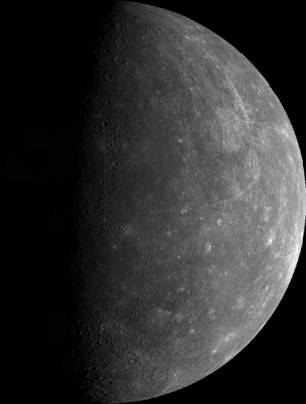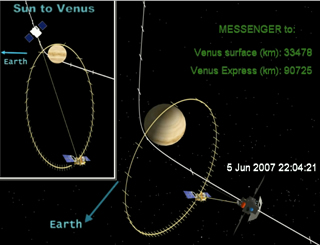07 June 2007

Mercury, the Closest Planet to the Sun
Image Credit: NASA-JPL
On 5 June 2007, NASA’s Mercury-bound MESSENGER spacecraft made its second flyby Venus, our nearest planet, for a gravity assist. This maneuver reduced the size of MESSENGER's orbit around the Sun, pulling it closer to Mercury. The spacecraft's velocity changed by nearly 24,000 km/hr.
Mission operators at the Johns Hopkins University Applied Physics Laboratory (APL) announced that MESSENGER’s systems performed flawlessly as the spacecraft dashed over the thick clouds of Venus, passing at an altitude of about 300 km above Venus' surface. The relative velocity was over 50,000 km/hr.
This second Venus flyby was a critical mission milestone in the probe’s circuitous journey toward Mercury orbit insertion, declared MESSENGER principal investigator Sean Solomon, from the Carnegie Institution of Washington. “Not only did the maneuver sharpen the spacecraft’s aim toward the first encounter with Mercury in more than three decades, it presented a special opportunity to calibrate several of our science instruments and learn new information about Earth’s nearest neighbor.”
MESSENGER was observing Venus in rhyme with European spacecraft Venus Express, which has been in orbit around our twin planet since April 2006.

Illustration showing the orbits of MESSENGER and Venus Express
Credit: JHUAPL
MESSENGER is scheduled to perform three flybys of Mercury in January and October 2008, and September 2009. During these flybys, MESSENGER will map most of the planet and study the surface and atmospheric composition. The spacecraft is scheduled to accomplish orbit insertion in March 2011. It will be the first artificial satellite of Sun-scorched Mercury. It will study the planet for one year.
MESSENGER is the second spacecraft to be sent toward Mercury in 33 years. It is also the seventh in NASA’s Discovery Program of lower-cost, scientifically focused space missions. APL built and operates the MESSENGER spacecraft and manages the mission for NASA’s Science Mission Directorate, Washington.
Further Reading
Mercury
http://www.nineplanets.org/mercury.html
Venus
http://www.nineplanets.org/venus.html
NASA's MESSENGER Website
http://www.nasa.gov/messenger.
APL's MESSENGER Homepage
http://messenger.jhuapl.edu/news_room/status_report_06_05_07.html
Venus Express
http://www.esa.int/SPECIALS/Venus_Express/index.html
Aymen Mohamed Ibrahem